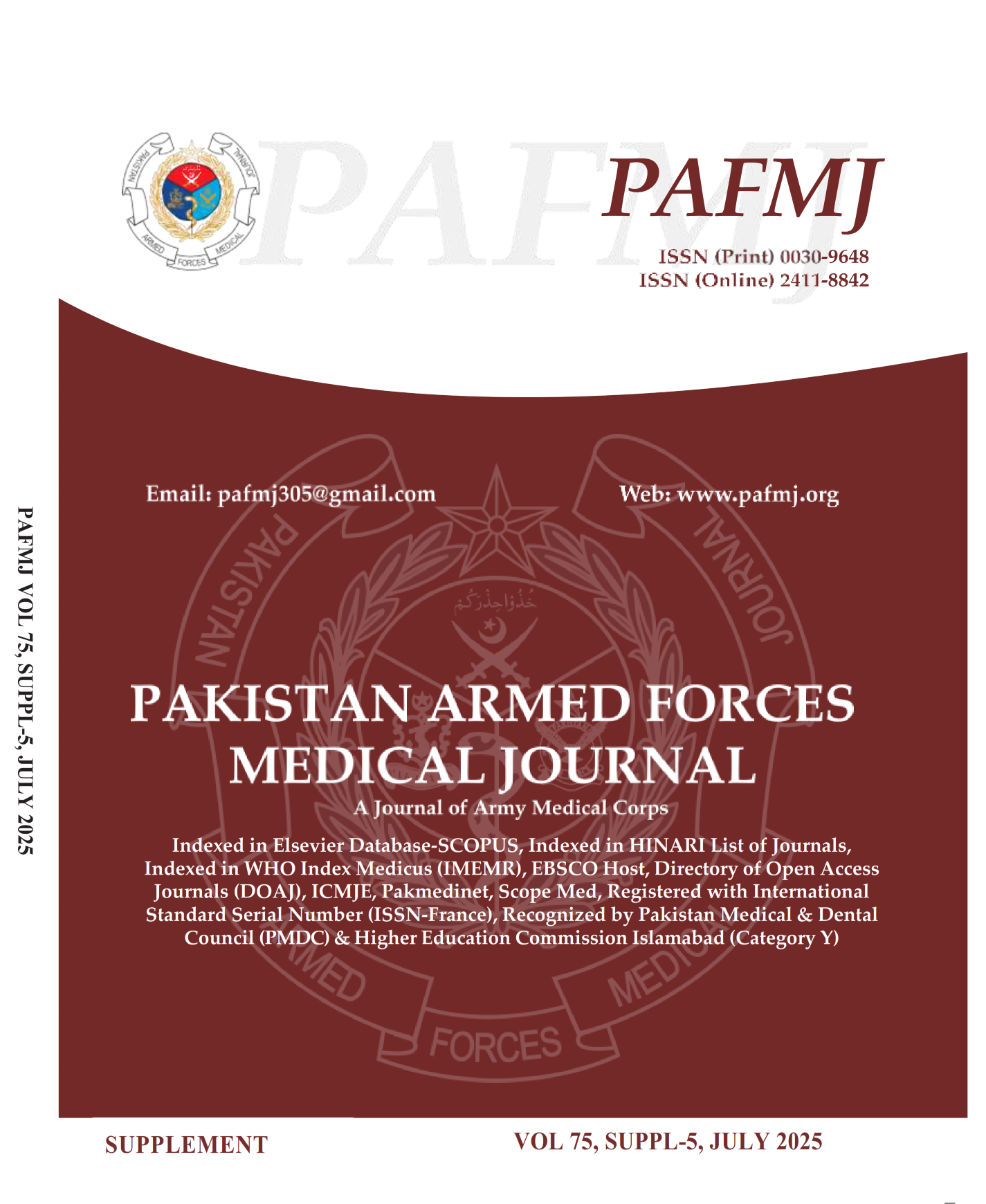The Strategy of the Surgical Team At Combined Military Hospital Peshawar During Mass Casualties In the Year January 2017 to April 2018
DOI:
https://doi.org/10.51253/pafmj.v75iSUPPL-5.9007Keywords:
Mass casualty, Lifesaving, Resuscitation, Triage, TraumaAbstract
Objective: to study the surgical and managerial management of mass casualties at CMH Peshawar.
Study design: Retrospective longitudinal study
Place and duration of study: CMH Peshawar, Pakistan from Jan 2017 to Apr 2018.
Methodology: We used patient documents to collect the data. When a mass casualty disaster arises, rapid communication between the forward medical team and CMH Peshawar, the number of victims, and the nature of injuries reaching CMH Peshawar are analysed. Surgical and anaesthesia teams organised themself to function in shifts so that the operation theatre could operate round the clock before the arrival of causalities. When the casualties are received, triage is performed, followed by trauma room examination and resuscitation of patients. Our team conducted Laboratory investigation, X-rays, FAST scans, and Doppler ultrasound in a trauma centre or ICU. We carried out lifesaving surgeries first, followed by limb saving surgeries.
Results: There were 12 mass casualties crises during 16 month period under study, with a total number of 218 casualties. The mean age was 34.46±12.06 years, with the youngest patient being 12 years old, and the oldest was 67 years old. There were 203(92.7%) males and 15(7.3%) females. In triage, 156(71.6%) were in the red area, 41(18.9%) in the yellow zone, and 21(9.7%) in the green zone. Lower limb injuries 83(38.1%) were the most predominant, followed by upper limb (48, 22.0%), chest (45, 20.6%), and .........
Conclusion: Mass casualty incidents (MCI) result in an unexpected influx of patients, requiring extraordinary .........
Downloads
References
1. Hirshberg A, Stein M, Walden R. Surgical resource utilisation in urban terrorist bombing: a computer simulation. J Trauma. 1999, 47(3): 545-50.
2. Hirshberg A, Scott BG, Granchi T, Wall MJ Jr, Mattox KL, Stein M. How does casualty load affect trauma care in urban bombing incidents? A quantitative analysis. J Trauma. 2005, 58(4): 686-93, discussion 694-5.
3. Stein M,Hirshberg A,Gerich T. Mass casualties after an explosion. Unfallchirurg. 2003; 106(10): 802-10.
4. Hirshberg A, Holcomb JB, Mattox KL. Hospital trauma care in multiple-casualty Incidents: a critical view. Ann Emerg Med. 2001; 37(6): 647-52.
5. Gutierrez de Ceballos JP, Turegano Fuentes F, Perez Diaz D, Sanz 'Sanchez M, Martin Llorente C, Guerrero Sanz JE. Casualties treated at the closest hospital in the Madrid, March 11, terrorist bombings.Crit Care Med. 2005: 33(1 Suppl): S107-12.
6. Lockey DJ, Mackenzie R, Redhead J, Wise D, Harris T, Weaver A, Hines K, Davies GE. London bombing July 2005: the immediateprehospital medical response. Resuscitation. 2005; 66(2): ix-xii. https://doi:10.1016/ j.resuscitation. 2005.07.005
7. Campion EM, Jullard C, Knudson MM, Dicker R, Cohen MJ, Mackersie R, CambellAR, Callout RA. Reconsidering the resources needed for multiple casualty events: lessons learned from the crash of asana airlines flight 214. JAMA Surg 2016; 151 : 512-7.
8. King DR, Larentzakis A, RamlyEP. Tourniquet use at boston marathon bombing: lost in translation. J Trauma Acute Care Surg 2015; 781: 594-9.
9. Havroon WS, Safcsak K, Corsa J, London A, Cheatham ML. Psychological effect of mass casualty events on general surgery residents. J Surg Educ 2017 ; 74 : e74 – e80.
10. Turegano-Fuentes F, Caba-Doussoux P, Jover-Navalon JM. Martin-Perez E, Fernandez-Luengas D, Diez~Valladares L, Perez-Diaz D, Yuste-Garcla laban P, Rios-Blanco R, Hernando-Trancho F,Garcia-Moreno F, Sanz$anchez M, Garcia-Fuentes C, Martinezvirto A, Leon-Baltasar JL, Vazquez- Estevez J. Injury patterns from major urban terrorist bombings in trains: the Madrid experience. World J Surg. 2008; 32(6): 1168--75.
11. Peleg K, Aharonson- Daniel L, Michael M, Shapira SC. Patterns of injury in hospitalized terronst vlcirms. Am J EmergMed. 2003; 21(4): 258-62.
12. Peleg K, Aharonson-Daniel L, Stein M, Michaelson M, Kluger Y, Simon D, Noji EK; Israeli Trauma Group (ITG). Gunshot and explosion injuries: characteristics, outcomes, and implications for care of terror-related injuries in Israel. Ann Surg. 2004; 239(3): 311-8.
13. Rotondo MF, Schwab CW, McGonigal MD, et al. 'Damage control': an approach for improved survival in exsanguinating penetrating abdominal injury. The Journal of Trauma. 1993; 35(3): 375-82.
14. Muhammad Ateeq, Shazia Jahan, Hanif M .Damage control surgery. Professional med j. jan – mar 2009; 16(1): 12-6.
15. Lipsky AM, Gausche-Hill M, Henneman PL, Loffredo AJ, Eckhardt PB, Cryer HG, de Virgilio C, Klein SL, Bongard FS, Lewis RJ. Prehospital hypotension is a predictor of the need for an emergent, therapeutic operation in trauma patients with normal systolic blood pressure in the emergency department. J Trauma. 2006; 61(5): 1228-33.
16. Kautza BC, Cohen MJ, Cuschieri J, et al; Inflammation and the Host Response to Injury Investigators. Changes in massive transfusion over time: an early shift in the right direction? J Trauma Acute Care Surg. 2012; 72(1): 106-111.
17. Soffer D, Klausner J, Bar-Zohar D, Szold O, Schulman CI, Halpern P, Shimonov A, Hareuveni M, Ben-Tal O. Usage of blood products in multiple-casualty incidents: the experience of a level I trauma center in Israel. Arch Surg. 2008; 143(10): 983-9.
18. Beekley AC, Martin MJ, Spinella PC, Telian SP, Holcomb JB. Predicting resource needs for multiple and mass casualty events in combat: lessons learned from combat support hospital experience in Operation Iraqi Freedom. J Trauma. 2009; 66(4 Suppl): S129-37.
19. Propper BW, Rasmussen TE, Davidson SB, Vandenberg SL, Clouse WD, Burkhardt GE, Gifford SM, Johannigman JA. Surgical response to multiple casualty incidents following single explosive events. Ann Surg. 2009; 250(2): 311-5.
Downloads
Published
Issue
Section
License
Copyright (c) 2025 Ejaz Ashraf Mallhi, Mujahid Zulfiqar, Rana hussan Javed, Salahudin Masood, Sadaf Aziz

This work is licensed under a Creative Commons Attribution-NonCommercial 4.0 International License.















